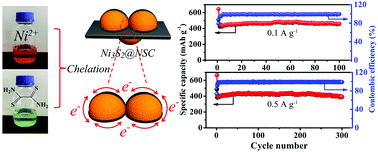Metal chelate induced in situ wrapping of Ni3S2 nanoparticles into N, S-codoped carbon networks for highly efficient sodium storage†
Abstract
Carbon-confined transition metal sulfides (TMS@C), featured with excellent redox reversibility, good electrical conductivity and high theoretical capacity, are considered to be promising anode materials for sodium-ion batteries (SIBs). Unfortunately, a large amount of additional S sources are involved in traditional preparation strategies, such as S powder, thiourea, L-cysteine, etc., resulting in the release of dangerous and poisonous H2S or residues of free S in final products. Therefore, developing a facile approach for eco-friendly synthesis of TMS@C remains a big challenge. Herein, a novel approach is developed to realize the facile fabrication of TMS@C from metal-dithiooxamide chelate (MDC) without additional S sources, which effectively reduces the release of H2S and avoids the residue of free S. In this strategy, dithiooxamide (DTO) with superior coordination ability coordinates with Ni2+ for the fine generation of the Ni-MDC precursor that is converted to N, S-codoped carbon-confined Ni3S2 nanoparticles (Ni3S2@NSC) after an in situ self-carbonization and self-sulfidation process. Benefiting from the rich heteroatoms in DTO, high doping contents of N and S in the carbon matrix can be obtained. When evaluated as an anode material for SIBs, Ni3S2@NSC exhibits excellent sodium storage performance with high reversible capacity (458.1 mA h g−1 after 100 cycles at 0.1 A g−1), superior rate capability (323.3 mA h g−1 at 2 A g−1) and robust long-term cycling stability (392.6 mA h g−1 after 300 cycles at 0.5 A g−1), which outperform those of nickel sulfide-based electrodes reported so far. More importantly, the strategy by employing MDC as a versatile precursor and template in this work should be promisingly applied in the fabrication of other heteroatom-doped TMS@C for efficient energy storage and conversion.

- This article is part of the themed collection: 2019 Inorganic Chemistry Frontiers HOT articles


 Please wait while we load your content...
Please wait while we load your content...